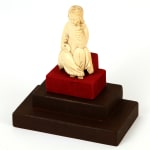Menino Jesus Salvador do Mundo Sino-Português / A Sino-Portuguese Baby Jesus Salvatori Mundi, China, c. 1600
marfim / ivory
Alt. / H. : 9 cm
F821
Further images
This Sino-Portuguese piece from the 16/ 17th Century, finely sculpted ivory, represent the seated Baby Jesus in contemplation, absorbed in his meditation.The physionomy of the face belies the Chinese influence with its serenity and expression, denoting deep spirituality and mysticism. The head has a high forehead, the hair with a central parting, is styled in the Buddhist manner with large curls to the front, a sign of superior intelligence, with the locks falling to the shoulders carved in fine parallel lines, terminating in stylized ringlets. The eyes are round and slightly protruding, set in deep sockets, with the mouth beautifully delineated and lips slightly parted.One hand holds the terrestrial Globe as befits the Saviour of the World, and His face rests lightly in the other, with the index and middle fingers extended in the way of blessing acknowledged as dignified and majestic in Europe.He is seated in an Oriental manner vested in a simple tunic without decoration, yet crafted in a way that delineates His body and shows the seated form and crossed legs. The feet are crossed yet remain side by side, in the Chinese fashion. The iconic image of the Infant Jesus, Salvatore Mundi, was originally spread throughout Europe of the 15th Century from the Flemish city of Malines (Mechelen) in the province of Antwerp, and became a symbol of the Devotio Moderna, the new movement to encourage the devotion to God in the homes and lives of the people through contemplation and meditation of the humanity of God.It was religiously themed images and engravings, that in the 16th and 17th Centuries travelled from Europe to the Orient, firstly by the Portuguese discovers, traders and missionaries, and used to the evangelization of the people of the Orient in a manner most easily understood.The two pieces presented here receive the influence of the European style while showing the influence of the Buddhist model of the image of the Baby Jesus as The Good Shepherd from the Indo-Portuguese Iconography: Jesus seated with legs crossed, not standing on their feet as in the Mechelen Babys and the overall aspect of the posture of deep contemplation from the Indo-Portuguese art.Bernardo Ferrão remarks that, contrary to the Baby Jesus from Indo-Portuguese origin, this two seated Infants are extremely rare in the Luso-Oriental Imagination.Identical pieces can be found in the collection of Arq. José Lico and are reproduced in the catalogue of the exhibition A Expansão Portuguesa e a Arte do Marfim (1991, p. 116)
BIBLIOGRAPHY:- Um Olhar do Porto – Uma Colecção de Artes Decorativas (Cat.), Funchal, Quinta das Cruzes – Museu, 2005. - SILVA, Nuno Vassallo (coord.) Marfins no Imperio Português, Lisboa, Scribe, 2013.- TÁVORA, Bernardo Tavares e, Imaginária Luso Oriental, Lisboa, IN-CN, 1983. - RAPOSO, Francisco Hipólito (coord.), A Expansão Portuguesa e a Arte do Marfim, Lisboa, C.N.C.D.P./F. C. G., 1991.
Menino Jesus sino-português em marfim, do séc. XVII. De grande qualidade escultórica, o menino encontra- se sentado em atitude de profunda meditação. A face é serena, com traços orientais, os cabelos bem desenhados com singelos caracóis periféricos e esboça um leve sorriso.Veste túnica simples, desprovida de qualquer adorno. Está sentado, com as pernas cruzadas à maneira oriental, deixando ver as pontas dos pés. Segura na mão direita a orbe terrestre, tem o cotovelo esquerdo apoiado no joelho e apoia os dedos na face.
BIBLIOGRAPHY:- Um Olhar do Porto – Uma Colecção de Artes Decorativas (Cat.), Funchal, Quinta das Cruzes – Museu, 2005. - SILVA, Nuno Vassallo (coord.) Marfins no Imperio Português, Lisboa, Scribe, 2013.- TÁVORA, Bernardo Tavares e, Imaginária Luso Oriental, Lisboa, IN-CN, 1983. - RAPOSO, Francisco Hipólito (coord.), A Expansão Portuguesa e a Arte do Marfim, Lisboa, C.N.C.D.P./F. C. G., 1991.
Menino Jesus sino-português em marfim, do séc. XVII. De grande qualidade escultórica, o menino encontra- se sentado em atitude de profunda meditação. A face é serena, com traços orientais, os cabelos bem desenhados com singelos caracóis periféricos e esboça um leve sorriso.Veste túnica simples, desprovida de qualquer adorno. Está sentado, com as pernas cruzadas à maneira oriental, deixando ver as pontas dos pés. Segura na mão direita a orbe terrestre, tem o cotovelo esquerdo apoiado no joelho e apoia os dedos na face.
Receba as novidades!
* campos obrigatórios
Processaremos os seus dados pessoais que forneceu de acordo com nossa política de privacidade (disponível mediante solicitação). Pode cancelar a sua assinatura ou alterar as suas preferências a qualquer momento clicando no link nos nossos emails.









